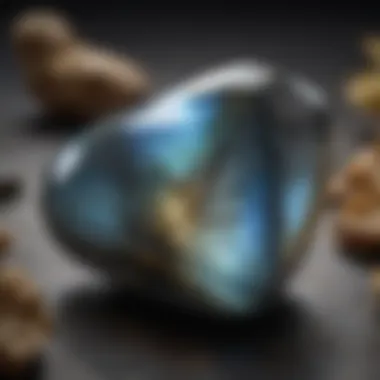Unveiling the Secrets of Identifying Tumbled Stones: A Comprehensive Guide


Rock and Fossil Identification
Identifying tumbled stones is a meticulous practice in the realm of rock and fossil enthusiasts. Various types of rocks and fossils can undergo the tumbling process, resulting in smooth, polished surfaces. When scrutinizing tumbled stones, collectors should look for distinct characteristics such as color variations, patterns, and surface texture. Utilizing tools like magnifying glasses and UV lights can aid in the identification process, allowing for a closer examination of the stones' unique features.
Collecting Tips and Techniques
For those delving into the world of tumbled stones, adopting best practices is essential for a fruitful collecting experience. Locating prime collecting sites necessitates research into areas abundant with raw materials suitable for tumbling. Extracting specimens safely involves using appropriate tools and techniques to avoid damage to the stones. By adhering to careful extraction methods, collectors can ensure the preservation of the stones' natural beauty.
Preservation and Display
Preserving tumbled stones requires attention to detail and proper techniques to maintain their aesthetics. Implementing preservation methods such as cleaning with gentle brushes and storing in protective containers can prevent damage over time. When considering creative display ideas, collectors can showcase their tumbled stones in various ways, including using shadow boxes, display cases, or incorporating them into jewelry pieces for unique arrangements.
Geological Insights
Exploring the geological aspects of tumbled stones unveils their fascinating origins and historical significance. Understanding the geological formations and processes that influence the formation of rocks and fossils enriches collectors' appreciation for these natural wonders. Delving into notable discoveries in the field sheds light on the intricate findings that continue to pique the interest of enthusiasts worldwide.
Tumbled stones hold a particular allure for rock and fossil collectors, embodying a unique blend of beauty and geological significance. In this section, we delve into the intriguing world of identifying tumbled stones, shedding light on essential techniques and insights that will enrich your collecting journey. By understanding the key characteristics and distinctive attributes of tumbled stones, enthusiasts can develop a discerning eye and a deep appreciation for these natural treasures. Furthermore, the ability to differentiate between various types of tumbled stones enhances not only your knowledge but also the value of your collection, making this topic a pivotal starting point for any rock enthusiast.
Understanding Tumbled Stones
Understanding tumbled stones is a crucial aspect of this article as it lays the foundation for recognizing the essence and significance of these polished gemstones. By delving into the depths of understanding tumbled stones, individuals can gain a profound insight into the meticulous process and craftsmanship involved in their creation. This comprehension elevates one's appreciation for the artistry and geological marvel that tumbled stones embody. Moreover, understanding the nuances of tumbled stones empowers enthusiasts to distinguish between authentic specimens and imitations, facilitating informed decisions in their collections and acquisitions.
Definition of Tumbled Stones
Tumbled stones refer to small, polished gemstones created through a rigorous tumbling process. This process involves placing raw gemstones in a rotating barrel with abrasives and minerals, gradually smoothening and shaping them into lustrous, tactile treasures. Tumbled stones retain their natural properties while exhibiting a refined appearance, making them sought after for both aesthetic and metaphysical purposes. Their compact size and vibrant colors make them versatile for various applications, such as jewelry making, healing practices, and decorative displays.
Formation Process


The formation process of tumbled stones is an intricate journey that begins with selecting raw gemstones based on their unique qualities and characteristics. These gemstones undergo a series of abrasive treatments within a tumbling machine, where they are polished over an extended period to achieve a smooth, glossy finish. This methodical process aims to enhance the inherent beauty of the stones while preserving their natural essence. Through tumbling, rough surfaces become silky, textures refine, and colors intensify, resulting in captivating tumbled stones that captivate the beholder.
Popular Types of Tumbled Stones
A diverse array of tumbled stones exists in the realm of gems and minerals, each bearing distinct properties and aesthetics. From the serene blues of blue lace agate to the fiery energies of carnelian, popular types of tumbled stones span a spectrum of colors, correspondences, and metaphysical associations. Crystals like amethyst, quartz, and jasper are perennial favorites among collectors for their healing attributes and aesthetic appeal. Furthermore, semi-precious stones like lapis lazuli, fluorite, and obsidian offer a tapestry of hues and energies for enthusiasts to explore and integrate into their crystal practices.
Key Characteristics to Look For
When it comes to identifying tumbled stones, paying attention to key characteristics is essential for collectors and enthusiasts in the rock and fossil realm. Understanding the specific features that define each stone not only adds to their aesthetic appeal but also aids in authentication and appreciation. By focusing on color and luster, texture and shape, as well as inclusions and patterns, individuals can unravel the unique qualities of each stone and differentiate between various types.
Color and Luster
Color and luster are fundamental aspects when inspecting tumbled stones. The hues and shine of a stone can give vital clues about its composition, origin, and potential value. For instance, vibrant colors like deep blues or fiery reds may indicate the presence of certain minerals, while a high luster can suggest a polished surface due to tumbling or natural sheen. Examining the tones and shine of a tumbled stone under different lighting conditions can reveal nuanced details that enhance its overall allure.
Texture and Shape
The texture and shape of a tumbled stone play a significant role in its identification and aesthetic appeal. Smooth textures are often a result of tumbling processes, creating a pleasant feel and polished appearance. On the other hand, rough textures may indicate natural formations or unprocessed stones. Shapes can range from irregular to symmetrical, with each form holding clues to the stone's journey and uniqueness. By examining the surface feel and contours of a tumbled stone, collectors can appreciate its tactile qualities and detailed craftsmanship.
Inclusions and Patterns
Inclusions and patterns within tumbled stones offer a glimpse into their geological history and formation processes. Inclusions, such as specks of minerals or cracks, can add character to a stone and serve as identifying markers. Patterns, whether swirling veins or geometric arrangements, showcase the intricate designs within the stone and provide insight into its geological heritage. By studying these inclusions and patterns closely, enthusiasts can unravel the story embedded within each tumbled stone, enhancing their value and appreciation.
Methods for Identification
Identifying tumbled stones through various methods is a crucial aspect for rock and fossil enthusiasts. These methods provide valuable insights into the composition, authenticity, and unique characteristics of tumbled stones. By utilizing a combination of visual cues and scientific tests, individuals can effectively differentiate between various types of stones, enhancing their collecting experience.
Visual Inspection


Visual inspection is a fundamental method for identifying tumbled stones. By carefully examining the color, texture, and overall appearance of a stone, collectors can gather initial information about its potential mineral composition and origin. Factors such as brightness, transparency, and any visible inclusions play a significant role in determining the quality and authenticity of a tumbled stone. Experienced collectors often rely on keen observation skills to spot subtle nuances that indicate the unique properties of each stone.
Hardness Test
Conducting a hardness test is another essential technique in identifying tumbled stones. This test involves using a mineral hardness scale, such as the Mohs scale, to assess the scratch resistance of a stone. By determining the stone's hardness level, collectors can narrow down potential mineral options and rule out softer imitations or synthetic materials. The hardness test offers a quantitative measure to categorize stones based on their resistance to scratching, providing valuable information for further identification.
Specific Gravity Test
The specific gravity test is a precise method used to determine the density of tumbled stones. By measuring the stone's weight in air and water, collectors can calculate its specific gravity, which varies depending on the stone's mineral composition. This test helps differentiate between stones of similar appearance but different densities, aiding in the accurate identification of tumbled stones. Through specific gravity testing, collectors can validate the authenticity of stones and gain insights into their geological properties.
Light and UV Testing
Light and UV testing are advanced techniques employed to identify unique characteristics of tumbled stones. By subjecting stones to various lighting conditions, collectors can observe fluorescence, phosphorescence, and color changes that indicate specific mineral properties. UV testing, in particular, can reveal hidden features like fractures, coatings, or treatments that may affect the stone's value and authenticity. These specialized tests complement visual inspection, providing a comprehensive analysis of tumbled stones' distinct qualities.
Signs of Authenticity
In the realm of identifying tumbled stones, signs of authenticity play a pivotal role in ensuring collectors and enthusiasts acquire genuine and high-quality specimens. Understanding the authenticity of tumbled stones is essential for appreciating their rarity, value, and unique properties. This section delves into specific elements, benefits, and considerations surrounding signs of authenticity, shedding light on vital aspects that distinguish genuine tumbled stones from imitations.
Certifications and Documentation
Certifications and documentation serve as tangible evidence of a tumbled stone's authenticity and provenance. These official certificates provide essential information about the stone's origin, quality, and any treatments it might have undergone. When purchasing tumbled stones, collectors should look for recognized certifications from reputable gemological institutes or experts in the field. These documents not only authenticate the stone but also add to its credibility and value within the collector's community.
Source and Origins
The source and origins of tumbled stones are crucial factors in determining their authenticity and value. Different regions around the world produce specific types of stones unique to their geological makeup. Understanding the source provides insights into the stone's journey from formation to discovery. Moreover, knowing the origins helps collectors appreciate the cultural significance and historical relevance of the tumbled stones in their collection. By tracing back the source and origins, collectors can ensure the authenticity and integrity of their prized specimens.
Common Mistakes to Avoid


In the realm of tumbled stones, avoiding common errors during identification is pivotal in maintaining the integrity of your collection and maximizing its value. This section delves into crucial missteps that collectors often make and provides insights on how to steer clear of them.
It is paramount to stress the significance of attention to detail when examining tumbled stones. One prevalent mistake that novices commit is overlooking key features that distinguish one stone from another. By disregarding subtle variations in color, texture, or inclusions, collectors risk misidentifying stones and undervaluing their specimens.
Additionally, rushing through the identification process is a common pitfall. Impatience can lead to oversight of essential characteristics that define a tumbled stone's uniqueness. Taking the time to thoroughly inspect each stone ensures precision and accuracy in classification.
Furthermore, neglecting to research and educate oneself about different tumbled stones can result in misjudgments. Lack of knowledge about geological properties and origins may lead collectors to false assumptions about a stone's worth. Embracing continuous learning and seeking expert advice are vital in avoiding such misinterpretations.
To mitigate these errors, collectors should also be cautious of forgeries and mislabeled stones. Without proper authentication and documentation, it is easy to fall prey to scams in the market. Verifying the source and obtaining certifications for tumbled stones are essential steps in ensuring their authenticity and quality.
By heeding these insights and being vigilant in the identification process, collectors can enhance their expertise, build a reputable collection, and appreciate the true value of tumbled stones.
Overlooking Key Features
Delving deeper into the significance of not overlooking key features when identifying tumbled stones, it becomes evident that meticulous observation plays a pivotal role in accurate classification.
One critical feature often disregarded is the presence of unique inclusions within a tumbled stone. These inclusions, such as mineral deposits or striking patterns, not only add to the aesthetic appeal of the stone but also serve as identifying markers for specific types. By dismissing the intricate details within a stone, collectors risk missing out on valuable information that defines its rarity and authenticity.
Moreover, texture and shape are fundamental aspects that should not be underestimated during the identification process. The tactile qualities of a stone, whether smooth, rough, or patterned, provide valuable clues to its geological formation and characterization. By neglecting to assess these attributes comprehensively, collectors might overlook key indicators that distinguish one tumbled stone from another.
Color and luster, although seemingly basic, are often mistakenly overlooked by enthusiasts. The interplay of hues and the reflective quality of a stone's surface reveal essential information about its composition and potential rarity. By honing in on these visual cues, collectors can develop a keen eye for discerning the true beauty and worth of tumbled stones.
By ensuring a detailed examination of each stone and paying close attention to its distinct features, collectors can elevate their identification skills and appreciation for the diverse world of tumbled stones.
Conclusion
In the realm of identifying tumbled stones, the conclusion plays a pivotal role in cementing the knowledge and insights gained throughout this comprehensive guide. By delving into the intricate world of tumbled stones, enthusiasts and collectors can elevate their appreciation for these unique geological wonders. The essence of the conclusion lies in summarizing the key elements discussed within this article, offering a final reflection on the significance of identifying tumbled stones.
One of the fundamental benefits of the conclusion section is its ability to consolidate the diverse methods, characteristics, and considerations highlighted in earlier sections. It serves as a cohesive endpoint that encapsulates the essence of discerning tumbled stones, providing a holistic perspective for rock and fossil enthusiasts. By revisiting the essential aspects covered, such as visual inspection, hardness testing, and authenticity markers, readers can reaffirm their understanding of the identification process.
Moreover, the conclusion acts as a compass guiding collectors towards distinguishing between genuine tumbled stones and potential imitations or misidentified specimens. Through a careful examination of certifications, source origins, and key features, individuals can navigate the intricate landscape of tumbled stones with confidence and acumen. This section serves as a crucial pillar in promoting meticulous research and diligence among collectors, fostering a community of informed enthusiasts passionate about rocks and fossils.
In essence, the conclusion of this article not only consolidates the wealth of knowledge shared but also inspires a deeper appreciation for the art of identifying tumbled stones. By emphasizing the importance of attention to detail, thorough examination, and a discerning eye, readers are equipped with the tools necessary to embark on a fulfilling journey in the world of tumbled stones.







